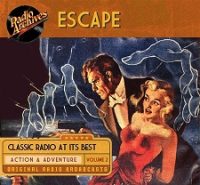
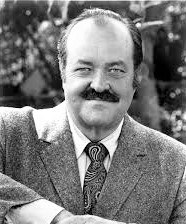
[Please welcome returning guest-host Jonathan Sherwood as he fills in for Ye Ed while he is away at Libertycon 34. Jonathan brings us one of the most popular Escape stories in its 7-year history, one which we hope you will enjoy as well. He writes of himself that his “love of old radio dramas began when he fell asleep each night listening to The CBS Radio Mystery Theater. These days he writes his own fiction, which has appeared in Asimov’s, Analog, and others, and he’s collected thousands of radio dramas that he still listens to as he falls asleep.”]
Escape (1947-54) first aired “Leiningen Versus the Ants” on January 14, 1948 as its 23rd episode out of approximately 230 original scripts, with William Conrad’s iconic, gravelly baritone teasing the episode with the show’s ominous opening line: “You’re isolated on a remote plantation in the remote Amazon jungle, and an immense army of ravenous ants is closing in on you, swarming in to eat you alive—a deadly black army from which there is no escape.”
“Leiningen Versus the Ants” had a long and successful history on the radio, airing on Suspense!, Lux Radio Theater, Mystery in the Air, and in three separate productions of Escape. The story’s highest profile was the 1954 movie The Naked Jungle starring Charleton Heston (1923-2008).
The original short story, by Carleton Smith, appeared in the December 1938 issue of Esquire alongside works such as Ernest Hemingway’s “The Butterfly and the Tank.”
The story takes place on a cocoa plantation in the Brazilian rainforest. Leiningen, the plantation’s owner, is a stubborn man who believes his prodigious will and self assuredness elevate him above other men. When a giant column of ants several square miles in size marches toward his plantation devouring everything in its path, he vows to stay and fight, rather than run away as the natives and his neighbors do. The action of the story consists of dams and moats, gasoline and fire, as Leiningen and his men work to out think and outmaneuver the incessant horde of insects.
Interestingly, the aforementioned William Conrad (1920-1994, photo top right), the most familiar and easily recognized of Escape’s hosts, also starred in the January 14, 1948 and May 23, 1948 productions as Leiningen himself, and would then go on to star in the 1954 film as the district commissioner opposite Heston. A third production from Escape, in August 4, 1949, starred Tudor Owen as Leiningen.
Though the original story and early radio broadcasts concentrate heavily on the fight against the ants, the ants appear only in the last fifteen minutes of The Naked Jungle. Instead, the movie focuses almost entirely on the love affair between Leiningen and multi-nominated Academy Award movie star Eleanor Parker (1922-2013) who plays his mail-order bride Joanna, which adds solid character development for Leiningen, but significantly changes the intent of the story and the original radio plays. On June 7, 1954, just three months after the movie was released in theaters, Heston reprised his role as Leiningen in The Naked Jungle for an hour-long episode of Lux Radio Theater.
Enjoy one of radio theater’s most popular man-against-nature stories. Whether you see Leiningen as a hero or a pig-headed fool, it’s a treat to listen to him pit his ego and will against the “deadly black army,” and decide for yourself whether he was a fool for staying, or a hero for refusing to yield.
{The CD cover above includes 20 remastered episodes including “Leiningen Versus the Ants.”}


Play Time: 29:36
{“Leiningen Versus the Ants” aired on a Wednesday evening in January of 1948. The following afternoon after school and bundled up in their warmest winter attire, the neighborhood gang stomped snow from their boots as they entered the nearby newsstand, on the prowl for larger game than deadly ants to fire their imaginations and warm their blood. They were in luck. Detective Tales (1935-51) featured 12 stories for a dime in nearly all of its 18-year run. It was a monthly in 1948. Ten Detective Aces (1928-41) started out focusing on stories written around the gangster element, but in 1930, with the interest in gangsters beginning to fade, it switched to a more traditional detective magazine, which was a winning formula fueling its success for the next 16 years. It was a bi-monthly in 1948. 10-Story Detective (1938-49) was a younger companion magazine to Ten Detective Aces. It ran stories geared toward those enjoying action-filled police and detective fare. It, too, was a bi-monthly in 1948.}
[Left: Detective Tales, 1/48 – Center: Ten Detective Aces, 1/48 – Right: 10-Story Detective, 2/48]
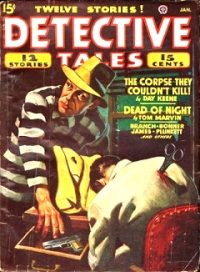
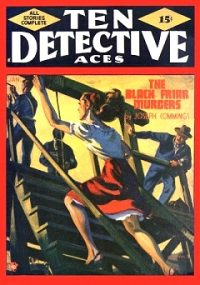
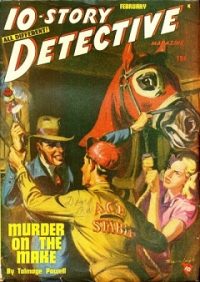
To view the entire list of weekly Old Time Radio episodes at Tangent Online, click here.